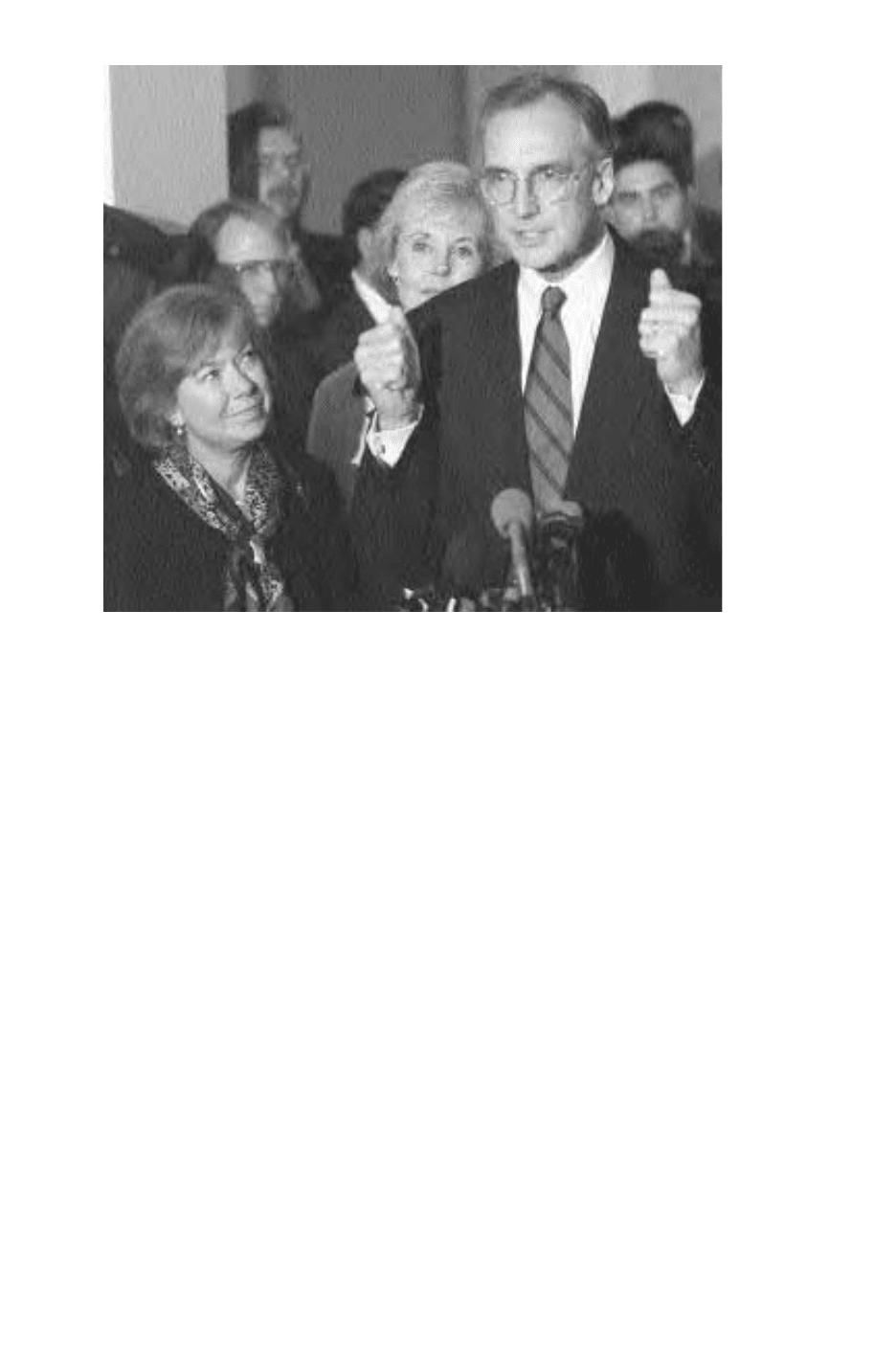Schenken Suzanne O’Dea. From Suffrage to the Senate: An Encyclopedia of American Women in Politics (2 Volumes)
Подождите немного. Документ загружается.


Roosevelt’s election, held offices in them, and ran for statewide offices
themselves on the party’s ticket.
Among the more notable women involved in the party were Jane Ad-
dams and Ruth Hanna McCormick. Addams became the first woman to
nominate a major political candidate when she gave her speech for
Theodore Roosevelt at the 1912 convention. McCormick served as an im-
portant member of the party’s campaign committee. Women promoted
the Progressive Party as the one most likely to help women gain suffrage
and as the party that offered women the opportunity to have a national
voice in politics.
See also Addams, Jane; Democratic Party, Women in the; McCormick Simms,
Ruth Hanna; Republican Party, Women in the
References Dinkin, Before Equal Suffrage: Women in Partisan Politics from Colo-
nial Times to 1920 (1995).
Pro-Life Action League
Founded in 1980 by Joseph M. Scheidler, the Pro-Life Action League
(PLAL) seeks to prevent abortion through direct action, including picket-
ing, closing abortion clinics, and sidewalk counseling. Sidewalk counsel-
ing, which PLAL considers one of its more effective strategies, involves ap-
proaching women going into abortion clinics and attempting to persuade
them not to proceed with their abortions. PLAL demonstrates at abortion
clinics, offices of prochoice organizations, and homes of physicians who
perform abortions. In addition, PLAL leaders take pride in their ability to
infiltrate prochoice conventions and monitor prochoice activities. PLAL
lobbies Congress and state legislatures and takes credit for Illinois’s re-
strictive abortion laws. In addition, the organization opposes birth control
and sex education in public schools.
PLAL has been the target of several lawsuits, including NOW v.
Scheidler, a case that went to the U.S. Supreme Court. In the case, the Na-
tional Organization for Women (NOW) sued Operation Rescue, the Pro-
Life Action League, other groups, and Joseph Scheidler, alleging the de-
fendants were part of a nationwide conspiracy that sought to close
abortion clinics. In 1994, the U.S. Supreme Court found that the Racke-
teer Influenced and Corrupt Organizations Act applied to the coalition of
antiabortion groups, but it did not decide the merits of the lawsuit.
See also Abortion; National Organization for Women; NOW v Scheidler; Oper-
ation Rescue
References Blanchard, The Anti-Abortion Movement and the Rise of the Religious
Right: From Polite to Fiery Protest (1994); Bradley, “NOW v. Scheidler: RICO
Meets the First Amendment” (1995).
Pro-Life Action League 549

Protective Legislation
Protective legislation emerged as a social reform issue in the last decades
of the nineteenth century. Through it, advocates sought to shield work-
ers from the harshest abuses and the health and safety hazards of factory
work, mining, and other industries. The U.S. Supreme Court’s rejection
of the laws that covered women and men led social reformers to limit leg-
islation to women and children. The Women’s Trade Union League, the
National Consumers League, and other groups worked for the passage of
legislation that limited the number of hours per day and the number of
days per week that women and children could work, prohibited them
from working at night, established minimum pay, limited the amount of
weight they could lift, and excluded them from certain occupations.
Massachusetts passed the first effective protective legislation in 1874, a
measure that limited women and children to working ten hours per day.
By 1900, fourteen states had passed comparable measures. The U.S.
Supreme Court accepted measures that were limited to women in Muller
v. Oregon (1908), and by 1960, every state had some form of protective
legislation.
When Congress passed Title VII of the Civil Rights Act of 1964, the
measure made discrimination on the basis of sex illegal. The law did not
specifically address protective legislation, but the Equal Employment Op-
portunity Commission concluded that protective legislation discrimi-
nated on the basis of sex and that the federal policy overruled state laws.
See also Civil Rights Act of 1964, Title VII; Equal Rights Amendment; Muller v.
Oregon; National Consumers League; Women’s Trade Union League
References Baer, The Chains of Protection: The Judicial Response to Women’s
Labor Legislation (1978); Lehrer, Origins of Protective Labor Legislation for
Women, 1905–1925 (1987).
Pryce, Deborah (b. 1951)
Republican Deborah Pryce of Ohio entered the U.S. House of Representa-
tives on 3 January 1993. Pryce held the leadership position of House con-
ference secretary in the 105th and 106th Congresses (1997–2001). A fiscal
conservative, Pryce told the House: “For the Democrats, it is the American
people who have too much money. For us Republicans, it is the govern-
ment that has too much.” She has been a leader in efforts to fight congres-
sional spending, win passage of national term limits legislation, and enact
a constitutional amendment to balance the budget. A member of the
Decorum and Civility Task Force, which works to improve relations be-
tween parties and foster civil conduct in the House of Representatives, she
has also worked to improve deliberations and accountability in the House.
550 Protective Legislation

Born in Warren, Ohio, Pryce received her bachelor of arts degree
from Ohio State University in 1973 and her law degree from Capital Uni-
versity in 1976. A prosecutor for eight years, her first elected post was to
the Franklin County Municipal Court as a judge, where she served from
1985 to 1992.
See also Congress, Women in
References Congressional Quarterly, Politics in America 1996 (1995);
www.house.gov/pryce/prycebio.htm.
Public Offices, Women Elected to
Women have been elected to public offices since the late nineteenth cen-
tury. Laura J. Eisenhuth, North Dakota superintendent of public instruc-
tion from 1893 to 1895, was the first woman elected to a statewide public
office. Susannah Medora Salter of Argonia, Kansas, was the first woman
mayor in the United States, serving from 1887 to 1889. Colorado was the
first state to elect women to its state legislature, sending three women to
its House of Representatives in 1894. Republican Jeannette Rankin of
Montana was the first woman elected to Congress, entering the House of
Representatives in 1917. The first woman governor was Democrat Nellie
Tayloe Ross of Wyoming, who served from 1925 to 1927. By 1969, how-
ever, only twenty-three women held statewide elective executive offices, or
Public Offices, Women Elected to 551
Representative
Deborah Pryce
(R-OH) with
Representative
Jennifer Dunn
(R-WA) supported
the short-lived elec-
tion of Representative
Bob Livingston
(R-LA) as speaker
of the House, 1998
(Associated Press AP)

6.6 percent of the 346 offices in the nation. Over the next thirty years, the
number grew to ninety-one women in statewide elective executive offices,
or 28.2 percent of 323 offices. (In the meantime, states had eliminated cer-
tain offices, combined them with other offices, or made them appointed
positions.)
Several factors account for the small number of women who have
served in public offices. Although women in some states, including Mon-
tana, had voting rights when Rankin was elected to Congress, U.S. women
did not gain full suffrage rights until the ratification of the Nineteenth
Amendment in 1920. Of the women who developed political experience
as leaders in the suffrage movement, few sought public office, and fewer
succeeded.
Women found that the Democratic and Republican Parties did not
welcome them into their decisionmaking circles, appoint them to party
positions, or recommend them for appointive positions in government.
Seeking equality in the parties has been a long struggle for women, one
that has received significant attention from women and from party lead-
ers. The parties also resisted nominating women for public office unless it
appeared that that party’s candidate had virtually no chance of winning
the general election. For example, in 1924, of the five Democratic women
running for Congress, four of them ran in Republican districts, and the
lone Republican woman ran in the South. Only Democrat Mary T. Norton
of New Jersey won that year because of the backing of the party’s machine.
Women have also found it difficult to raise the money needed to ad-
equately finance their campaigns, in part because so many ran as sacrificial
lambs for offices that they had little chance of winning. In the 1970s, the
National Women’s Political Caucus was founded to recruit women to pur-
sue public office and train candidates to run effective campaigns, as well as
help fund the campaigns. In the 1980s, EMILY’s List, the WISH List, and
other political action committees (PACs) formed to raise money for female
candidates’ campaigns. These groups have educated potential donors
about the necessity of candidates having adequate financing for their cam-
paigns and have raised substantial amounts of money, but money remains
a significant barrier to women’s candidacies and women’s successes.
Another factor for women seeking office is incumbency, which both
benefits women in office and poses a barrier to women challenging in-
cumbents. In the 1998 elections, all fifty women seeking reelection to the
U.S. House of Representatives won. Of the seventeen women nominated
by a major party who ran for open seats, six won, but none of the fifty-
four women challenging House incumbents won. In the U.S. Senate, three
of the four women seeking reelection won, one of the two women running
for open seats won, and none of the four women challengers won. Both
552 Public Offices, Women Elected to

women governors who ran for reelection won, and thirty-four of the
thirty-six women incumbents seeking statewide offices won.
Arizona made history in the 1998 elections when voters elected
women to all five statewide executive positions in the line of constitu-
tional succession. The governor, secretary of state, attorney general, state
treasurer, and state superintendent of schools in Arizona are all women,
the first time any state has selected women for all its top offices.
See also Congress, Women in; Democratic Party, Women in the; EMILY’s List;
Landes, Bertha Ethel Knight; Republican Party, Women in the; State Legisla-
tures, Women in; WISH List
References Center for the American Woman and Politics, National Information
Bank on Women in Public Office, Rutgers University.
Public Speaking
In the early nineteenth century, several barriers stood between women
and their participation in society. One of the first obstacles that women
overcame was the social and religious prohibition against their speaking
in public before audiences of women and men. Women’s public silence
had its roots in St. Paul’s admonition that women should not be permit-
ted to speak, a rule that the dominant Protestant churches heeded. In ad-
dition, it was considered unseemly for women to be heard in public. The
exception was women of the Quaker religion, who were permitted to
speak in meetings.
The first few women who broke through the barrier suffered the out-
rage of ministers and the public. In 1828 and 1829, Frances Wright, prob-
ably the first female public speaker in the United States, advocated equal
education for women and men. Notorious for speaking in public and for
her ideas, she attracted both large audiences and condemnation from the
pulpit and the press. African American Maria Stewart was likely the next
female public speaker, lecturing in Boston in 1832 and 1833 on abolition
and educational opportunities for girls.
The two women who truly opened the public lecture stage to women
were Angelina and Sarah Grimké, the first female agents of the American
Anti-Slavery Society. These two sisters went on several speaking tours be-
tween 1837 and 1839. Attacked by churches for speaking in public, the
Grimké sisters responded to their critics by articulating the connection
between slavery and women’s rights and arguing that women needed
equality in order to take their places in the fight against slavery. In 1838,
Angelina Grimké entered new territory for women when she spoke to the
Massachusetts legislature on the need to end the slave trade in Washing-
ton, D.C. She was the first woman to speak to a legislative body. The
Grimké sisters broke the public speaking barrier, and other women soon
Public Speaking 553

followed them, first calling for the end of slavery and then calling for
women’s rights.
See also Abolitionist Movement, Women in the; Grimké, Angelina Emily and
Sarah Moore; Stewart, Maria W.; Wright, Frances (Fanny)
References Flexner and Fitzpatrick, Century of Struggle: The Woman’s Rights
Movement in the United States (1996).
Pyle, Gladys (1890–1989)
Republican Gladys Pyle of South Dakota served in the U.S. Senate from 9
November 1938 to 3 January 1939 but was never sworn into office. She
was elected to the Senate following the death of the incumbent, but Con-
gress had adjourned before her election and did not convene until the new
Congress was organized following the 1938 general elections.
Pyle entered public service as the first woman elected to the South
Dakota House of Representatives, an office she held from 1923 to 1927.
She orchestrated the state’s ratification of the Child Labor Amendment in
1923 and worked to give women the right to serve on juries, a right
women gained in 1947. South Dakota secretary of state from 1927 to
1931, Pyle was the first woman in the state elected to hold a constitutional
office. As secretary of state, Pyle sponsored legislation for a safety code for
motor vehicles. In 1930, she lost in her attempt to become the Republican
Party’s candidate for governor, even though she received the most votes of
the five Republican candidates. To win the nomination, a candidate
needed at least 35 percent of the votes cast, which neither Pyle nor the
other candidates accomplished, and the decision went to the state Repub-
lican convention. The candidate who had received the fewest votes in the
election became the nominee. Appointed to the state’s securities commis-
sion, Pyle served from 1931 to 1933, again the first woman to serve on a
state commission. She was also a member of the South Dakota Board of
Charities and Corrections from 1943 to 1957.
Born in Huron, South Dakota, Gladys Pyle earned her bachelor of
arts degree from Huron College in 1911 and also studied at the American
Conservatory of Music for one year. She taught in public high schools
from 1912 to 1920.
See also Congress, Women in; State Legislatures, Women in
References Kinyon and Walz, The Incredible Gladys Pyle (1985); Office of the
Historian, U.S. House of Representatives, Women in Congress, 1917–1990
(1991).
554 Pyle, Gladys

Quaker Women
Quaker women emerged as the first group of European women in Amer-
ica to have public lives, a status that developed from their roles as preach-
ers and one that led them to take active and public roles in the temper-
ance, abolitionist, and suffrage movements. The tenets of the Quaker faith
provided the unusual independence Quaker women had from male au-
thority. Quakers believe that the “inner light” reveals the way to truth and
salvation and that it is available to both women and men, empowering
women and men and giving both authority. Among the nineteenth-cen-
tury Quaker women leaders were suffragists Susan B. Anthony and Lucre-
tia Mott.
See also Abolitionist Movement, Women in the; Anthony, Susan Brownell;
Mott, Lucretia Coffin; Suffrage; Temperance Movement, Women in the
References Matthews, The Rise of Public Woman: Woman’s Power and Woman’s
Place in the United States, 1630–1970 (1992).
Quinton, Amelia Stone (1833–1926)
Native American rights advocate Amelia Stone Quinton joined Mary L.
Bonney’s crusade in 1879 to protect the Oklahoma Territory from white
settlers and to save it for the Native Americans to whom it belonged.
Working with Bonney in the Central Indian Committee, which eventually
became the Women’s National Indian Association (WNIA), Quinton
planned and organized the efforts, and Bonney provided the financial
support. The WNIA advocated doing away with reservations, allotting
555
Q

private plots of land to individuals, and assimilating Native Americans
into white culture.
Quinton prepared research, drafted petitions, and organized other
groups to help with the petition effort. In 1882, Quinton and five others
presented President Chester A. Arthur with more than 100,000 signatures
on petitions for Native American land allotment, education, and citizen-
ship. She also made speeches, lobbied members of Congress, persuaded
others to send letters to Congress, and wrote articles. Quinton’s work sig-
nificantly contributed to the passage of the Dawes Act of 1887. Under the
measure’s provisions, Native Americans could exchange their participation
in tribal holdings for an individual land grant and American citizenship.
Quinton served as president of WNIA from 1887 to 1905. During
those years, the organization grew, expanding into the South and West
and from eighty-six auxiliaries to 120. She continued to lobby Congress,
particularly to improve conditions on reservations. With her health de-
clining, Quinton refused reelection to the presidency of WNIA in 1905.
She continued, however, to work for Native Americans until 1910.
Born in Jamesville, New York, Quinton received her education at
Cortland Academy in Homer, New York, and taught in girls’ seminaries
and academies. One of the earliest members of the Woman’s Christian
Temperance Union, she represented the organization and helped establish
new chapters from 1874 to 1877.
See also Bonney, Mary Lucinda; Woman’s Christian Temperance Union
References Hardy, American Women Civil Rights Activists (1993).
556 Quinton, Amelia Stone

Racial Discrimination
Racial discrimination in the United States has its roots in the enslavement
of Africans beginning in the seventeenth century. With the passage and
ratification of the Thirteenth Amendment to the U.S. Constitution, slav-
ery ended in the United States, but the amendment did not end discrimi-
nation on the basis of race. Throughout the nation, local and state laws
and policies as well as local customs authorized or permitted racial dis-
crimination at every level.
The U.S. Supreme Court’s 1954 decision in Brown v. Board of Educa-
tion of Topeka, Kansas, provided the first substantial federal policy to end
some discriminatory practices by ordering the end of segregated public
schools. Laws and policies requiring or permitting discrimination on the
basis of race in employment, housing, public accommodations, and higher
education, however, persisted until passage of the Civil Rights Act of 1964,
which prohibited those forms of discrimination. The Voting Rights Act of
1965 provided the legal basis and enforcement for ending policies that dis-
criminated against African Americans seeking to register to vote.
The first significant law restricting immigration into the United States
discriminated against the Chinese. The Chinese Exclusion Act of 1882 pro-
hibited Chinese immigration for ten years and was renewed in 1892 for an-
other ten years. Congress made Chinese immigration permanently illegal
in 1902. In addition, citizenship was denied to Chinese until 1943.
Official discrimination against Japanese immigrants was based upon
a “gentleman’s agreement” between President Theodore Roosevelt and
557
R

Japan made in 1907, prohibiting immigration from that country. Following
Japan’s bombing of Pearl Harbor in December 1941, the U.S. federal gov-
ernment forced all Japanese Americans, citizens and noncitizens, to leave
the West Coast. Forced to quickly dispose of their property, deprived of the
opportunity to continue their occupations, and placed into internment
camps, 100,000 people of Japanese descent were denied their constitutional
civil rights. The United States was also at war with Germany and Italy, but
people of those descents were not deprived of their freedoms. In addition,
the U.S. Supreme Court upheld the internment of Japanese immigrants and
people of Japanese descent. President Franklin Roosevelt withdrew the in-
ternment order in 1945 and the camps closed later that year. Japanese
Americans were reimbursed for lost property in 1968 and Congress gave
$20,000 to each of the 60,000 surviving internees in 1988.
Native Americans and Latinos have also endured racial discrimina-
tion that limited their access to education, housing, and employment. Like
the groups mentioned above, they have been denied their constitutional
civil rights, and often their pleas to obtain those rights have been rejected.
While the Civil Rights Act of 1964, affirmative action programs, and other
measures have attempted to address racial discrimination, the legacy of
racial discrimination continues to haunt American society and to limit
the full realization of the fundamental ideals of the U.S. Constitution.
See also Civil Rights Act of 1964, Title VII; Voting Rights Act of 1965
References Crawford, Rouse, and Woods, eds., Women in the Civil Rights
Movement: Trailblazers and Torchbearers, 1941–1965 (1990); Foner and
Garraty, The Reader’s Companion to American History (1991).
Radicalesbians
Founded in 1970, Radicalesbians resulted from attempts to purge lesbians
from the feminist movement. Labeled the “lavender menace” by feminist
and National Organization for Women (NOW) president Betty Friedan,
Rita Mae Brown and other lesbians left NOW to form a lesbian feminist
movement. At the second Congress to Unite Women, the lights went out
in the meeting hall, and when the lights came back on, they revealed sev-
eral lesbians wearing lavender T-shirts stenciled with the words “lavender
menace.” The women described their experiences as lesbians in a hetero-
sexual culture and distributed copies of the “The Woman-Identified
Woman,” a paper intended to assuage feminists’ fears of lesbianism. The
paper described lesbianism as a political choice that aligned women with
other women and not solely as a matter of sexual expression.
See also Brown, Rita Mae; Friedan, Betty Naomi Goldstein; Lesbian Rights;
National Organization for Women
References Wandersee, American Women in the 1970s: On the Move (1988).
558 Radicalesbians
